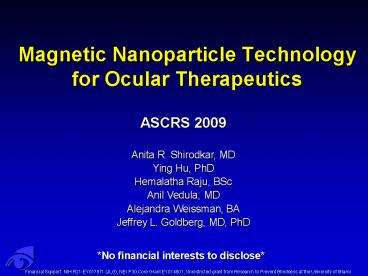Magnetic Nanoparticle Technology for Ocular Therapeutics - PowerPoint PPT Presentation
Title:
Magnetic Nanoparticle Technology for Ocular Therapeutics
Description:
Drug delivery, cell replacement therapy, gene therapy ... Prior research by Bray, et al, showed that by applying a direct 'towing' force ... – PowerPoint PPT presentation
Number of Views:236
Avg rating:3.0/5.0
Title: Magnetic Nanoparticle Technology for Ocular Therapeutics
1
Magnetic Nanoparticle Technology for Ocular
Therapeutics
ASCRS 2009 Anita R. Shirodkar, MD Ying Hu,
PhD Hemalatha Raju, BSc Anil Vedula, MD Alejandra
Weissman, BA Jeffrey L. Goldberg, MD, PhD
No financial interests to disclose
Financial Support NIH R21-EY017971 (JLG), NEI
P30 Core Grant EY014801, Unrestricted grant from
Research to Prevent Blindness at the University
of Miami
2
Magnetic Particles and Optic Nerve Injury
- Magnetic nanoparticles may be used for ocular
therapeutics - Drug delivery, cell replacement therapy, gene
therapy - Ocular toxicity from these particles remains
unknown - Retinal ganglion cell (RGC) axon damage is
important in the pathogenesis of many
degenerative diseases - Glaucoma, optic neuritis, optic ischemia, other
optic neuropathies - In all cases, RGCs are unable to regenerate their
axons after optic nerve injury - Could magnetic particles play a role in axon
stimulation?
3
Mechanical Tension Can Elongate Axons In Vitro
- Applying mechanical tension to a neuron can
stimulate axon elongation in vitro. - Prior research by Bray, et al, showed that by
applying a direct towing force to neurons via
glass microneedles can elicit axon elongation.
Neuron
4
Magnetically Applied Mechanical Tension In Vitro
Magnetic nanoparticle
Nerve cell
DeSilva et al
5
Can Magnetic Nanoparticles Localize to Injured
RGC Axons?
- In order to apply magnetic field-induced
mechanical tension in vivo, we must first attempt
to localize magnetic nanoparticles to an optic
nerve injury site.
Magnetic nanoparticles
Optic nerve injury
6
Methods of Nanoparticle Injection and Localization
Rat sacrificed after 24 hours
Sections viewed with fluorescence microscope
Optic nerve dissected in live anesthetized rat
Flourescence-labeled 50 nm magnetic
nanoparticles injected into nerve
Optic nerve removed sectioned
Forceps crush injury to optic nerve
7
Injected Nanoparticles Can Localize to Distal
Axon Tip
8
Injected Magnetic Nanoparticles Can Be Found
Within Cells
Confocal microscopy
9
Injected Magnetic Nanoparticles Label Cells In
Vivo
Nanoparticles on cell surface
Nanoparticles in vesicles
10
Magnetic Nanoparticles Are Nontoxic to Ocular
Structures
- Magnetic nanoparticle toxicity was evaluated in
rats. - Anterior chamber and intravitreal injections
- PBS versus 50 nm and 4 µm particles
- Parameters were evaluated at 1 hour and 7 days
- Retinal layer cell densities, IOP readings,
endothelial cell counts, histology,
immunofluorescence - Magnetic nanoparticles had no demonstrated
toxicity by any of the methods tested. - Microparticles were found to have statistically
lower endothelial cell counts at 7 days
11
Magnetic Nanoparticles A Promising
Future
- Magnetic nanoparticles injected into a rat optic
nerve can localize to the injured, distal axon
tips. - A subset of these particles are endocytosed
locally by optic nerve cells. - Ongoing experiments are directed at identifying
and optimizing the subcellular localization of
the nanoparticles, particularly focusing on
enhancing axon binding specificity. - Magnetic nanoparticles do not appear to be toxic
to ocular structures.
12
Future Directions
Explants
Magnet
Magnetic nanoparticles
Axon elongation
Injury Site
Magnet
In vivo elongation
Axon elongation
Magnetic nanoparticles































